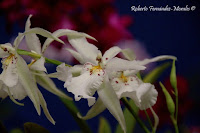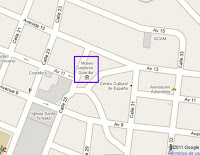Esta entrada fue actualizada el 13 de junio del 2014.
(This post was updated June 13th, 2014.)
2011 National Orchid Exposition
Encyclia cordigera (Kunth) Dressler
The Orchids National Fair takes place in the Old Principal Customs building. The building was opened in 1891, complementing the services provided by the Atlantic Railroad Station. This 4,160 square meters structure was constructed entirely of brick and it is one of the largest buildings of the 19th century preserved in the city of San Jose. It was declared Historical Relic on June 4th, 1980 and currently the Old Principal Customs building has become a center for arts and culture.
-----------------------------------
Click on the images to enlarge.
-----------------------------------
La exposición nacional de orquídeas se realiza en el edificio de la Antigua Aduana Principal. La edificación fue inaugurado en 1891, complementando los servicios brindados por la Estación del Ferrocarril al Atlántico. Este edificio de 4,160 metros cuadrados construidos totalmente en ladrillo, constituye uno de los edificios más grandes del siglo 19 conservados en la ciudad de San José. Fue declarado Reliquia Histórica el 4 de junio de 1980 y actualmente, la Antigua Aduana Principal se ha convertido en un centro de arte y cultura.
-----------------------------------
Haga click sobre las imágenes para agrandarlas.
-----------------------------------
Este es una mapa de la zona: (Fuente: Mapa de San José, disponible el 15 de abril del 2011).
(This is a map of the zone: (Source: San José Map, available on april 15th, 2011))
Mapa cultural de San José
(San José´s cultural map)
Mapa turístico de Costa Rica
(Costa Rica´s touristic map)
Antigua Aduana Principal
(Old Principal Customs building)


Fotografía de 1914
(Photograph of 1914)
Otras fotografías antiguas
(Other old photographs)
Croquis de la remodelación del Edificio de la Antigua Aduana
(Sketch of the remodeling of the Old Customs Building)


(Photograph of 1914)
Otras fotografías antiguas
(Other old photographs)
(Sketch of the remodeling of the Old Customs Building)
En nuestro país, se tienen aproximadamente 1,200 especies distribuidas en 178 géneros. La gran cantidad de especies se debe a las diferencias ecológicas que se presentan en el país con motivo de diversos factores climáticos. Por ser un país muy angosto y tener la influencia de dos océanos, se dan grandes diferencias de humedad en el ambiente, lo que hace que haya tanta diversidad de climas. Esto favorece el surgimiento de gran cantidad de especies diferentes. Costa Rica tiene una de las mayores densidades de éstas por unidad de área de territorio.
(In our country, there are about 1,200 species distributed in 178 genera. The large number of species is due to ecological differences that arise in the country because of various climatic factors. Since the country is very narrow and has the influence of two oceans, there are large differences in humidity in the environment, which means that there are so many different climates. This favors the emergence of large numbers of different species. Costa Rica has one of the highest densities of these per unit of area of territory.)
Cerca del edificio de la Antigua Aduana Principal se encuentra el de la terminal del Ferrocarril al Atlántico, la cual fue edificada en 1908. Su construcción fue producto del crecimiento económico que experiementó Costa Rica a principios del Siglo 20. No se conoce con certeza el nombre del constructor, ya que se cita entre ellos al Arquitecto Jaime Carranza ("Libro Azul de Costa Rica", 1916) y al Ingeniero Juan Dijón ("Conozca su país", 1940). Lo cierto es que es un bello edificio declarado Reliquia de Interés Histórico y Arquitectónico el 29 de junio de 1980. (Fuente: Carvajal Chinchilla Sergio, "Edificio Estación del Ferrocarril al Atlántico". Escuela de Ingeniería Civil, Universidad de Costa Rica. 1998).
(Near the Old Customs Building is the Main Terminal of the Atlantic Railroad, which was built in 1908. Its construction was a product of the economic growth that had Costa Rica in the early 20th century. It is not known with certainty the name of the constructor and cited among them are the architect Jaime Carranza (“Costa Rica Blue Book”, 1916) and the Engineer Juan Dijon (“Know your Country”, 1940). The truth is that it is a beautiful building, declared a Relic of Historical and Architectural Interest on June 29th, 1980. (Source: Carvajal Chinchilla Sergio, "Station Building of the Atlantic Railroad". Civil Engineering Department, University of Costa Rica. 1998).)
(Near the Old Customs Building is the Main Terminal of the Atlantic Railroad, which was built in 1908. Its construction was a product of the economic growth that had Costa Rica in the early 20th century. It is not known with certainty the name of the constructor and cited among them are the architect Jaime Carranza (“Costa Rica Blue Book”, 1916) and the Engineer Juan Dijon (“Know your Country”, 1940). The truth is that it is a beautiful building, declared a Relic of Historical and Architectural Interest on June 29th, 1980. (Source: Carvajal Chinchilla Sergio, "Station Building of the Atlantic Railroad". Civil Engineering Department, University of Costa Rica. 1998).)
Un par de fotografías antiguas. Un agradecimiento muy especial al Ing. Oscar Romero Cruz por enviarme el documento del cual se tomaron las fotografías. (Fuente: Costa Rica Railroad Co. Ltd. and Northern Railroad Company, 1953)
(A couple of old photographs. Special thanks for Mr. Oscar Romero Cruz, who send me the document from which the photographs were taken. (Source: Costa Rica Railroad Co. Ltd. and Northern Railroad Company, 1953))
Otras fotografías antiguas
(Other old photographs)
Otro edificio cercano a la Antigua Aduana principal es la Iglesia Santa Teresita.
La estructura fue diseñada en 1920 por el arquitecto José María Barrantes, uno de los principales exponentes de la arquitectura del siglo XX en Costa Rica. Esta iglesia es uno de los mejores exponentes del estilo neoclásico en nuestro país. Para la construcción se utilizó concreto reforzado y una estructura de acero importada de Bélgica.
Fue declarada al Patrimonio Histórico Arquitectónico de Costa Rica el 18 de febrero de 1999. (Fuente: Ministerio de Cultura y Juventud disponible el 17 de abril del 2011)
(Another construction near the Old Customs Buildings is the Santa Teresita Church. The building was designed in 1920 by the architect José María Barrantes, one of the leading exponents of twentieth century architecture in Costa Rica. This church is among the best exponents of the neoclassical style in our country. It was built with reinforced concrete and a steel structure imported from Belgium.
The church was declared Architectural Heritage of Costa Rica on February 18, 1999. (Source: Ministry of Culture and Youth available on april 17th, 2011))
En Calle 25 y Avenida 3 se encuentra el bello edificio Solera Chacón, contruido en 1948.
(On 25th Street and 3rd Avenue is located the beautiful Chacón Solera Building, constructed in 1948.)
En este sitio existió la Cantina El Piave
(On this corner was the Bar El Piave)
En Calle 25 y Avenida 3 se localiza otro antiguo edificio
(On 25th Streel and 3rd Avenue there is another old building)
La antigua casa de habitación del Expresidente de la República, Doctor Rafael Ángel Calderón Guardia, fue declarada Monumento Nacional según Ley Nº 6377, publicada en La Gaceta Nº 179 del 25 de septiembre de 1979.
(The former home of the ex-President of Costa Rica, Dr. Rafael Ángel Calderón Guardia, was declared a National Monument under Law No. 6377, published in La Gaceta No. 179 of September 25, 1979.)
Las siguientes entradas de este blog están relacionadas con la actual:
(The following posts of this blog are related to the actual one):
Más fotografías de Explore Costa Rica en Flickr -Roberto Fernández-Morales-.
(More photographs of Explore Costa Rica on Flickr -Roberto Fernández-Morales-.)
Conozca y cuide a Costa Rica. Es de todos nosotros!!
(Get to know and take care of Costa Rica. It belongs to all of us!!)































































































































































No hay comentarios.:
Publicar un comentario